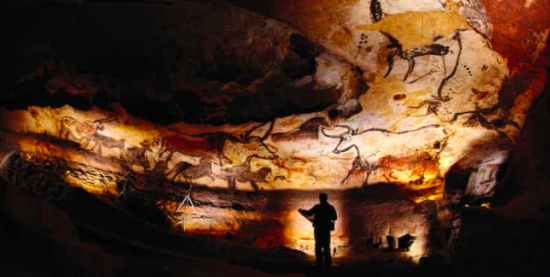In 1940, four teenage boys discovered a cave painting in Lascaux, France, when their dog went astray. When they looked for it, they followed their dog through the entrance of a cave, where there were at least one thousand pictures of various animals on the walls – one bull was nearly 17ft long. In shock, or because of the build-up of carbon dioxide in the cave, the boys began to dart around – they ‘went completely crazy,’ they said, and according to one of them the animals seemed to be moving. Imagine that you are these boys from Nazi-occupied France, you have travelled down some sort of rabbit hole to find yourself at the beginning of mankind and you are hallucinating a big dance of prehistoric beasts.

It is standard to consider beauty to be a creation of modern civilisations. Prehistoric art, for instance, is made not for an appreciation of aesthetics but for a particular use. When they were first discovered, cave paintings were suspected to be the attempt of prehistoric humans to attract the animals they wanted to eat, by some magical force. This theory is doubtful because not all the animals painted could be eaten- I don’t know who ate rhinos or who wanted to attract them to their cave, but I doubt they were massively popular. However, the reason I don’t agree with this is because the cave paintings are not simple representations of animals – they are observational recordings. Paint on stone has no need to turn its head to watch for predators. But these paintings were obviously of great importance to the people who made them; it would have been a significant effort to lug logs into the cave to build a scaffold for the artist to work on, or to mix the paint for the artist to use. Cave paintings would have been the product of not one artist, but a group of cave residents. The walls are an impractical surface to work on as well – it would be much easier to paint on a rock or some leather. Indeed, it is speculated now that cave men and women did not restrict their creations to the cave walls, but the caves are the only surviving images because they are kept safe from the elements and from aging by the heavy rock.
It is something of a mystery why cave paintings were first painted. Now that we have thousands of years of art and artistic influence, it is expected that humans will express themselves, and draw, and be creative. Thirty-five thousand years ago there was nothing but the natural world – where could the idea to paint have come from, I believe it is where humans became separate from the rest of the natural world: no other animal possesses the ability to see a value in viewing the world, or recording it, as we do with art and writing and the preservation of old artefacts in museums. A spider’s web is the work of an immensely skilled creator, but the spider has no ability to see any value the web may have other than to keep it alive. There is also a real complexity to the paintings; they are made of an economy of line that I would admire if they had been painted yesterday. The artist Amédée Ozenfant wrote in 1928 that the cave paintings inspired modern art – the first cave paintings were discovered in 1881, when modern art began, and certainly artists were moved by them – from Pollock to Picasso, who visited several caves in the 1930’s and is rumoured to have said that ‘After Lascaux, we have invented nothing.’
The conclusion that is often come to, is that it is in our nature to express ourselves, or to want to leave some evidence of ourselves behind. Early people would begin to paint on cave walls in every continent bar Antarctica – with no communication with each other; this development seems to be a natural step. Perhaps this a way in which cave paintings are valuable: they provide an insight into the nature of human expression which can be applied to art today. Art represents what is important to us – this can be seen in Early Netherlandish painting, where artists painted religious scenes using brushes made of the hairs of an ermine or a hog, or in much of traditional oil painting which flattered its subjects and depicted their power and wealth – such as the Ambassadors by Holbein.
You would think that early humans would choose to depict themselves in their paintings. But even when humans began to appear in cave paintings roughly twelve thousand years ago, they are largely puny and vulnerable compared to the enormous creatures that surround them, such precise renditions that we can identify the species thousands of years after. Animals were central to human life and aside from some handprints, there are no human faces in any cave paintings, there seems to be little sense of human identity in the subjects of the cave walls – a sharp contrast to today when usually the artist is the centre of his or her work. In a time when it is crucially important to value the natural world in order to save it, it is wonderful to consider that nature is able to humankind over a stretch of tens of thousands of years.
Scientists believe that early types of humans discovered fire and began to use tools around two million years ago. Homosapiens have existed for two hundred thousand years, and the first writing (and the first civilisations) are five thousand years old. (Woolly mammoths went extinct one thousand years after that.) Humans began to appear in cave paintings twelve thousand years ago, and the oldest painting (of a sort of hog) is thought to be thirty-five thousand years old. It is interesting to consider what sort of art a future human species might look at, and what they might think.
